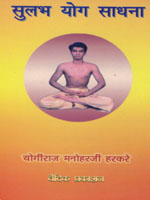Books
Bhagvadgita (Vyas meaning)
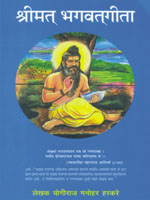 Bhagvadgita is the sacred book of Vedic religion and it is meant for all. In fact, the Gita provides guidelines for superior life and spiritual progress of a human being. But according to Yogiraj Harkare, Vyas was misinterpreted for a pretty long time. Thinkers like Mahatma Gandhi, Madhavacharya, Dr. Sukthankar took symbolic view of Bhagvadgita. But this approach was not fully developed.Yogiraj Manohar Harkare alias Kakaji developed ethical meaning of Gita fully, by adding his own yogic knowledge and experiences to it. He has written this unique book with the help of his profound Sadhana of Yoga.
Bhagvadgita is the sacred book of Vedic religion and it is meant for all. In fact, the Gita provides guidelines for superior life and spiritual progress of a human being. But according to Yogiraj Harkare, Vyas was misinterpreted for a pretty long time. Thinkers like Mahatma Gandhi, Madhavacharya, Dr. Sukthankar took symbolic view of Bhagvadgita. But this approach was not fully developed.Yogiraj Manohar Harkare alias Kakaji developed ethical meaning of Gita fully, by adding his own yogic knowledge and experiences to it. He has written this unique book with the help of his profound Sadhana of Yoga.His interpretation of Bhagwad Gita :
- The Gita is a treasure of modern sciences such as theory of relativity, quantum theory, science of probabilities, science of space and time and eternal ethical laws of death and birth.
- It also includes social and individual psychology.
- Deep studies of experiences of Yoga and para-existence have been authentically described in the Gita.
- It also contains a code of conduct in all spheres of life that are essential for elevation and emancipation of existence.
- The war in Mahabharata is the eternal war of tendencies fought every moment within the core of every human being trying for self realization.
- Characters and events in Mahabharata and Gita, represent either ethical virtue or vice. Yogiraj has analysed almost all names in Mahabharata in terms of good or bad tendencies. e.g. Dhritarashtra means blindness to one’s own spiritual gains. He is dominated by Duryodhana, i.e. adamant bad tendency. And needs to be guided by Sanjay i.e.balanced intellect.
Kundalini:
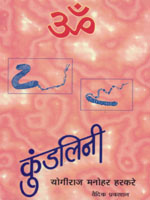
- The highest apex further than Yoga practice is awakening of Kundalini.
- Kundalini Jagruti/ awakening leads to highest self realization and bestows strength and splendor.
- Kundalini Jagruti or awakening by merely touching a head or by Śaktipāt. Prpoer and guided efforts i.e. Sadhana is needed.
- When iron converts into a magnet all its molecules are totally transformed likewise by our own efforts and yoga practice we can make such transformation happen in all our body cells when Kundalini awakens.
- What is Kundalini? What is kundalini Jagruti ?
In this book, all such questions are explained scientifically for the first time.
Sadhana, Sadhak and Divyanubhuti
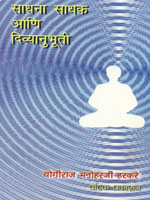 In this book, Kakaji tells how every Sadhak can get the divine experience or Divyanubhuti and achieve Yoga Siddhis. This is a very remarkable stand of a Yoga-Sadhak.Our body is made of 5 elements namely, Earth, Water, Fire, Air and Space. In every human being, one of these 5 elements supersedes. This decides the nature and capacity of every human body. Appropriate Sadhana is depicted by Kakaji to gain divine experiences. This divine experience comes in stages. These stages are experienced one by one, culminating into Divyanubhuti. Scientific interpretation of this process is discussed in this book.
In this book, Kakaji tells how every Sadhak can get the divine experience or Divyanubhuti and achieve Yoga Siddhis. This is a very remarkable stand of a Yoga-Sadhak.Our body is made of 5 elements namely, Earth, Water, Fire, Air and Space. In every human being, one of these 5 elements supersedes. This decides the nature and capacity of every human body. Appropriate Sadhana is depicted by Kakaji to gain divine experiences. This divine experience comes in stages. These stages are experienced one by one, culminating into Divyanubhuti. Scientific interpretation of this process is discussed in this book.
Vaidik Sananche Yograhahsya
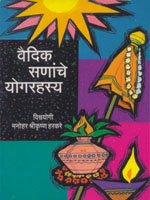
Vaidik Vishwa missionaries believe that all festivals are to be celebrated by realising spiritual purposes behind them. The science of yoga (Yoga Shastra) is the foundation of Vaidik tradition. So, all dealings in Vaidik life are based on Yogashastra. Yoga means scientific efforts to acquire spiritual knowledge, thus the emphasis is to celebrate the festivals in scientific ways.In this book Kakaji discusses science behind all seasons, their names, their significance and ways of celebrating festivals related to them.eg. On the day of Vijayadashmi, Ram kills Ravana – the symbolic meaning is Sadhak’s victory over his bad tendencies. Simolanghan – (crossing the border of the city) a Sadhak should go beyond the limits laid down for common man and distribute gold in the form of knowledge.
Before birth ... After death (Mystery of birth and death)
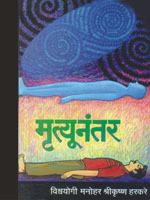 Nobody knows knowledge and science before birth and after death. But everybody is curious to know more about it. Today’s science also is not capable of solving this mystery. People try to solve this mystery. Kakaji throws light on this mystery and explains it scientifically. Where were we before birth? We get body from our parents, then how does our soul enter the body? And when?
Nobody knows knowledge and science before birth and after death. But everybody is curious to know more about it. Today’s science also is not capable of solving this mystery. People try to solve this mystery. Kakaji throws light on this mystery and explains it scientifically. Where were we before birth? We get body from our parents, then how does our soul enter the body? And when?After birth, we perform several Karmas/ deeds with our body as means and we mould our soul. Our materialistic body has four bodies in it. What happens to our soul after death, what is rebirth, how it is destined? Life after death how is it like? All these questions and mysteries are discussed. Scientific and superior spiritual experiences are narrated. eg. With proper Sadhana, one can take out subtle body out of physical body and bring it in again. This book includes scientific and spiritual knowledge of life before death and life after death.
Sulabh Yoga Sadhana
- Yogasanas are only 1/8 part of Ashtang Yoga.
- Body is the means to nurture soul, so to keep it pure and supportive, we must perform Yogasanas the first step towards Sadhana.
- The steps of Asanas should be followed by Pranayam. Pranayam leads a Sadhak to gain mind control.
- Then follows the stage of Dhyan. Dhyan increases efficiency of the Sadhak and leads him to spiritual progress.
- Yogiraj has experienced himself Omkar Shatchakrabhedan and Yog-Nidra. He claims that all these Kriyas / yogic processes are attainable to anybody. Self-experience depends on physical and spiritual ability of a Sadhak. Tratak Sadhana is a simple way for self-revelation.
Ramayan Rahasya
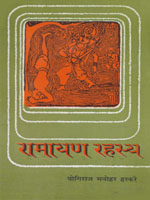 Rampatra : Rampatra is the preface / foreword written to the book ‘Ramayan Rahasya’. Here, Yogiraj makes the reader aware of the fact that the Ramayana and the Mahabharata are not historical events or mythology. He explains metaphors and symbols from Ramayana methodically. He believes that these symbols are stages experienced in Yog-Sadhana and these for the betterment of mankind.
Rampatra : Rampatra is the preface / foreword written to the book ‘Ramayan Rahasya’. Here, Yogiraj makes the reader aware of the fact that the Ramayana and the Mahabharata are not historical events or mythology. He explains metaphors and symbols from Ramayana methodically. He believes that these symbols are stages experienced in Yog-Sadhana and these for the betterment of mankind.
When Yogiraj was young, he had a faith that Ramayana and Mahabharata are epics of historical events. After a persistent Sadhana and getting yogic experiences beyond senses, he became a staunch believer that these epics in fact describe divine experiences achieved by Yoga. He found that many scholars who have no Yogic experience fail to understand this. Sages like Yogiraj Vasudevananda Saraswati, Mahatma Gandhi, Hon. Golvalkar Guruji and many others considered these epics not as historical events. Yogiraj Manoharji studied views of these philosophers and found that these epics are related to progressive yogic stages of a sadhak.
Yogiraj Manoharji came across a yogi who asked him, ”Ram broke Shivdhanuhsya, do you know into how many pieces?” As told by that Yogi, Yogiraji pierced his fingers at 2 places through his spinal chord (Merudanda) and witnessed that they went through breaking it into 3 pieces. Thus the yogi enlightened him that Ramayana is a symbolic epic of human life.
As a Sadhak of advanced Yoga, Yogiraj Manoharji alias Kakaji, understood the real meaning of this incident later.
Kakaji tells one more episode of Avayava-Chhedan (intersection of limbs by Yoga) by Shri Sai Baba. Shri Saibaba had attained that extrasensory yogic power of Avayava Cheddan. Kakaji tells that his devotees had witnessed it. This Yogic action is possible only to great yogis.
One of the Sadhaks /followers of Kakaji, himself experienced such an extrasensory condition during Yog-Sadhana. The epic of Ramayana is the metaphor of ideal spiritual experiences vital for life. True spiritualists must make people aware about this.
Further in the foreword, Kakaji elaborately discusses some principles of Jain and Buddhist philosophy in this light.
Metaphors from Ramayan
Ram symbolizes a Yogi-Sahdhak. He broke Shivdhanushya into pieces- this is the Avayava Chhedan of Merudanda (spinal chord). This experience can be achieved by superior Yoga practice only. Ram broke Shivdhnushya and got married to Sita (self-experience). He gave up worldly life and along with Sita (self-experience) and Laxmana (discretion/ prudence) eminent Yogi Ram lived in the forest Dandakaranya (for doing the penance of Merudanda Sadhana). After carrying out such Sadhana for 14 years with maturity and prudence, a Sadhak can become one with his soul.Dandakaranya is a forest, where the house namely Panchvati is made of five senses. Ram cuts ears and nose of Shurpanakha (Avyava Chhedan or desire for women) and kills the golden deer i.e. covetousness. He has left his kingdom too. Thus, Ram is ready for Sadhana after giving up his all materialistic wishes. As Laxman (prudence) follows him Ram performs his Yog-Sadhana. Royal self-experience (Sita) is taken away by Brahmadnyana Ravan. When Sita, self-experience is lost, Ram becomes desperate and yearns for her. Laxman keeps his balance. The air element, Hanuman, meets Ram at Pampa Sarovar, the water element, and helps him to find out Sita. Sita is found at Brahmarup Ravan. Since Ravan has taken her away, Ram has to fight with him to get her back. This is the battle between good and evil attitudes. In this battle Ram kills Kumbhakarna who symbolizes Sadhana done by only listening. Other ill wills are also killed in this attitudinal war of Ram and Ravan. Egoistic Ravan has a son Indrajit, who has command over his limbs. Ram asks Laxman to kill Indrajit who is busy performing Yadnya. Brahmavastha is in the form of Ravan. He is egotistic as he has mastery over Vedas and knowledge. So Ram has to target his heart, meaning thereby, he has to change the mind-set totally and nurture that good attitude. Ravan is thus merged into Ram. Sita, self-experience, acquires grace of Brahmadnyan but has to go through an ordeal. Now, Sita is sacred, pure and symbolizes divine self-experience. She is also waiting to meet Ram after her stay with Brahmanubhuti. Ram and Sita and Laxman return to Ayodhya, a place where there is no war but peace. Ram symbolizes a Yogi-sadhak leading a peaceful life. Sita conceives two virtues namely Lav (time) and Kush (penance). Thus Ram achieves authority for Samdahivastha. But Story of Ramayan continues.

